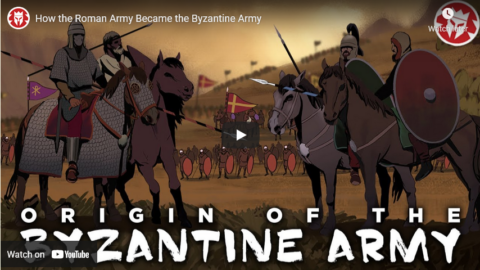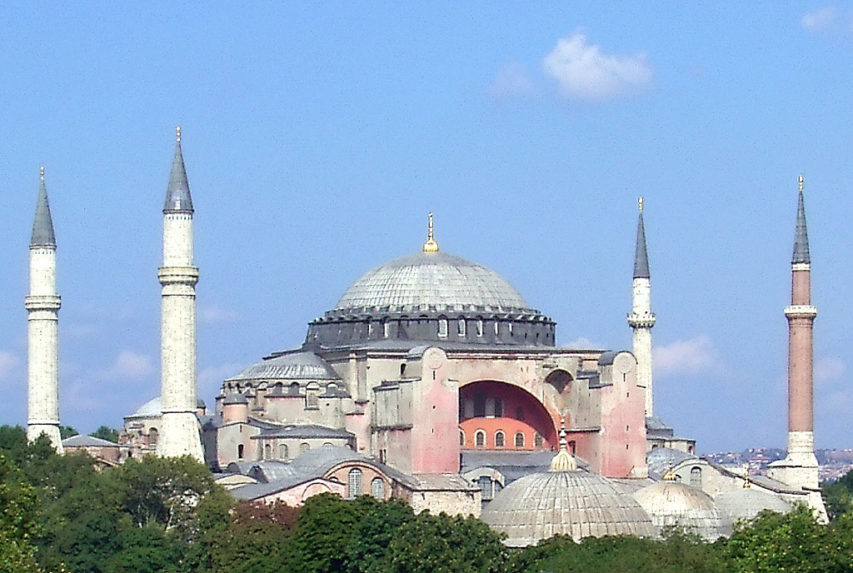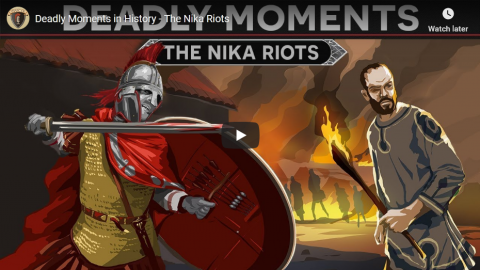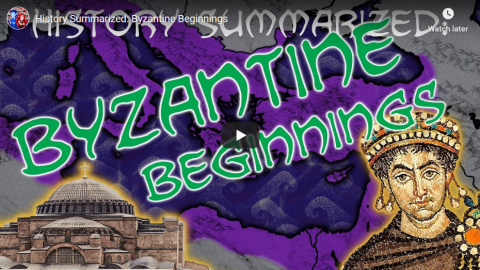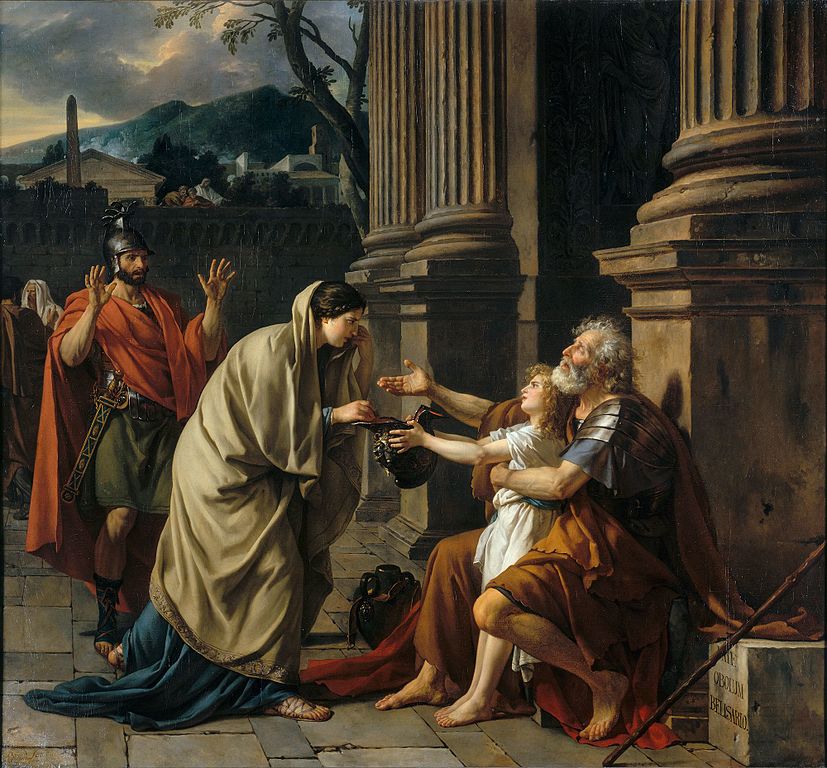Kings and Generals
Published 2 Mar 2021Video is Sponsored by Ridge Wallet: https://www.ridge.com/KINGSANDGENERALS Use Code “
KINGSANDGENERALS” for 10% off your order!The Kings and Generals animated historical documentary series on the evolution of the Roman Army continues with the first episode of the series on the Army of the Eastern Roman Empire — the Byzantine Empire. In this episode, we’ll mainly focus on how the Roman army was transformed into the Byzantine army and talk about the armies of Justinian and Belisarius described by Procopius.
Support us on Patreon: http://www.patreon.com/KingsandGenerals or Paypal: http://paypal.me/kingsandgenerals. We are grateful to our patrons and sponsors, who made this video possible: https://docs.google.com/document/d/1o…
The video was made by our Arb Paninken http://bit.ly/2Ow3oC8, while the script was developed by Leo Stone. This video was narrated by Officially Devin (https://www.youtube.com/user/OfficiallyDevin)
✔ Merch store ► teespring.com/stores/kingsandgenerals
✔ Podcast ► Google Play: http://bit.ly/2QDF7y0 iTunes: https://apple.co/2QTuMNG
✔ Twitter ► https://twitter.com/KingsGenerals
✔ Instagram ► http://www.instagram.com/Kings_GeneralsProduction Music courtesy of Epidemic Sound: http://www.epidemicsound.com
#Documentary #Byzantines #Romans
March 4, 2021
How the Roman Army Became the Byzantine Army
December 13, 2020
How the Romans Stole Silk Production Secrets from China
Kings and Generals
Published 31 Jan 2019Go to https://www.wix.com/KingsAndGenerals to get started on your website today!
Check out our new website at http://kingsandgenerals.orgSilk production was one of the biggest secrets of China and one of the most lucrative industries of the age. So it is not a surprise that the Roman emperor Justinian was eager to learn this secret. In this video we will discuss the start of the silk production, its importance and the story of how Justinian managed one of the first industrial thefts in history
Support us on Patreon: http://www.patreon.com/KingsandGenerals or Paypal: http://paypal.me/kingsandgenerals
Check out our Merch Store: teespring.com/stores/kingsandgenerals
We are grateful to our patrons and youtube members, who made this video possible: https://drive.google.com/open?id=1Xa-…
The video was made by our friend Cogito
This video was narrated by Officially Devin (https://www.youtube.com/user/Official…)
✔ Merch store ► teespring.com/stores/kingsandgenerals
✔ Podcast ► Google Play: http://bit.ly/2QDF7y0 iTunes: https://apple.co/2QTuMNG
✔ Twitter ► https://twitter.com/KingsGenerals
✔ Instagram ► http://www.instagram.com/Kings_GeneralsProduction Music courtesy of Epidemic Sound: http://www.epidemicsound.com
#Documentary #Justinian #Silk
July 26, 2020
Hagia Sophia
Lars Brownworth (author of the excellent Lost to the West: The Forgotten Byzantine Empire That Rescued Western Civilization) on the building of the Hagia Sophia by Eastern Roman Emperor Justinian in Constantinople:
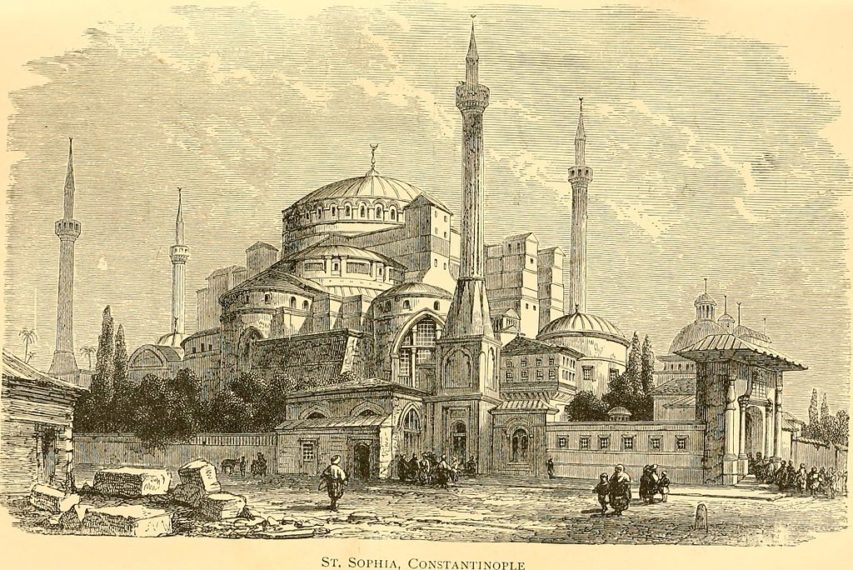
Illustration of the Hagia Sophia from European History: An outline of its development by George Burton Adams, 1899.
Wikimedia Commons
The Hagia Sophia was the brainchild of a unique figure in history. At birth, Justinian was a nobody among nobodies in a grindingly poor part of what is today North Macedonia. By his mid-40s, he was a Byzantine emperor. His appetites were large, his dreams larger. The man who knew what it was like to have nothing gave new meaning to the idea of luxury. For one memorable celebration, he spent almost two tons of gold on decorations.
Justinian had no time for small things. By the second year of his reign, he had decided to codify all of Roman law, founded several new cities, and had started construction on at least eight new churches.
The money for all these projects inevitably came from the public. And by the fifth year of his reign, his subjects had had enough. Already upset by rampant corruption, an inefficient bureaucracy, and crushing taxes, they hit the boiling point when Justinian severely restricted public games. A mob tore through the streets, overwhelming the unprepared police forces. Several stores were set on fire, and the wind quickly spread the flames to a nearby hospital, which burned down with its patients inside. An inferno raged. For five long days, Constantinople burned.
By the time Justinian reasserted control, more than 30,000 citizens were dead, and perhaps a third of the city was a blackened shell. It looked as if some barbarian horde had sacked the capital. The fact that its own people had inflicted such a wound hovered like a black cloud over the streets.
Characteristically, Justinian saw a perfect opportunity within the ashes. This was a blank canvas on which to create a new city in his image. The transformation would begin with the cathedral. The original building, known simply as the Magna Ecclesia — the Great Church — had been built by a son of Constantine the Great in the fourth century, but had burned down a few decades later. Since it was a standard Roman basilica — a large hall with square walls and angled wooden roof — it had been fairly easy to rebuild along the same lines.
But of course, Justinian had no intention of following the tired plans of an earlier age. This was a chance to remake the cathedral on a new scale, something worthy of the ages. It was to be nothing short of a revolution, equal parts art and architecture, the enduring grandeur of the emperor himself frozen in physical form.
Everything about this project was audacious, including his selection of architects. Instead of choosing a traditional builder, he picked two teachers who — like himself — had more vision than practical experience. This was a lifelong pattern with Justinian. He had a habit of plucking genius out of the common crush; his wife was a reformed prostitute, and his greatest generals were an elderly eunuch and a former bodyguard.
The emperor’s instructions to Isidore of Miletus, a physics teacher, and Anthemius of Tralles, a mathematician, should have terrified them. They merely had to design and successfully build a church unlike anything else the world had seen. Sheer scale wasn’t enough — the empire was full of grand monuments and immense sculpture. This had to be something different, something fitting for the new golden age that was dawning. Expense wasn’t an issue, but speed was. Justinian was already in his 50s, and he didn’t intend to have some successor apply the final coat of paint and claim the project as his own.
June 2, 2020
The Fall Of The Roman Empire With Tom Holland | History Hit LIVE on Timeline
Timeline – World History Documentaries
Published 29 May 2020The Roman Empire remains one of the most enduring and prolific civilisations of written history. Yet it, like all great civilisations, would eventually come to an end. Join Dan Snow as he speaks to historian Tom Holland about the many contributing factors that would bring this seismic and seemingly invincible empire to its knees.
#StayHome #WithMe #FallOfRome
April 11, 2020
Pandemics Economically Worse than War – The First Pandemic – Pandemic History 01
TimeGhost History
Published 10 Apr 2020There is much we can learn from past pandemics, like how Emperor Justinian ruined the Eastern Roman Empire’s economy and made the first plague pandemic even worse.
Join us on Patreon: https://www.patreon.com/TimeGhostHistory
Hosted by: Indy Neidell and Spartacus Olsson
Written by: Spartacus Olsson
Directed by: Astrid Deinhard
Executive Producers: Bodo Rittenauer, Astrid Deinhard, Indy Neidell, Spartacus Olsson
Creative Producer: Joram Appel
Post-Production Director: Wieke KapteijnsResearch by: Spartacus Olsson
Edited by: Spartacus OlssonArchive by Reuters/Screenocean http://screenocean.com
A TimeGhost chronological documentary produced by OnLion Entertainment GmbH.
From the comments:
TimeGhost History
3 minutes ago
As announced, here is the first instalment of our impromptu series on the history of pandemics. Now, as you will see in the video this is not just a reaction to the current COVID-19 pandemic, but very much back to the roots for us. Indy studied the pandemics extensively back in university times, and to study history in general requires a somewhat morbid fascination with human disaster in general. So we have spent many, many years looking intently at the worst disasters that have befallen humanity — and there is nothing worse than disease, especially on a pandemic scale. Hopefully this is the time when we can share a bit of that amassed knowledge to add a little timely understanding of the greater effects of pandemics, beyond the immediate tragic medical ones, like how they have impacted society, the economy, and human life in general throughout history. While we cannot give you fixed schedule for this series (we have the regular programming to take care of) we will try to come out with the next one very soon.A note on a statement I make in the video: when I say COVID-19 might be the first time we successfully fight back a pandemic, I am saying that fully aware of the eradication of small pox and the near eradication of polio, the flu vaccine successes and so on — but that is avoidance of recurring pandemics of a specific kind and we have made more progress there than actually handling pandemics of a new disease when they break out for the first time. On that note, take care, stay safe, and may you be healthy despite these trying times.
Spartacus
February 15, 2020
The Best Couples in History — Valentine’s Day Special
Overly Sarcastic Productions
Published 14 Feb 2020Happy Valentine’s Day! Celebrate the history of Love with a rundown of these outstanding couples — for better and for worse.
Our content is intended for teenage audiences and up.
This video was edited by Sophia Ricciardi, AKA “Indigo”.
PATREON: https://www.Patreon.com/OSP
DISCORD: https://discord.gg/h3AqJPe
MERCH LINKS: https://www.redbubble.com/people/OSPY…OUR WEBSITE: https://www.OverlySarcasticProductions.com
Find us on Twitter https://www.Twitter.com/OSPYouTube
Find us on Reddit https://www.Reddit.com/r/OSP/
January 13, 2020
The Nika riots in Constantinople (with bonus NASCAR analogies)
Not only does Tamara Keel provide interesting and informative gun information, she also has at least a vague interest in late Classical/early Medieval history:
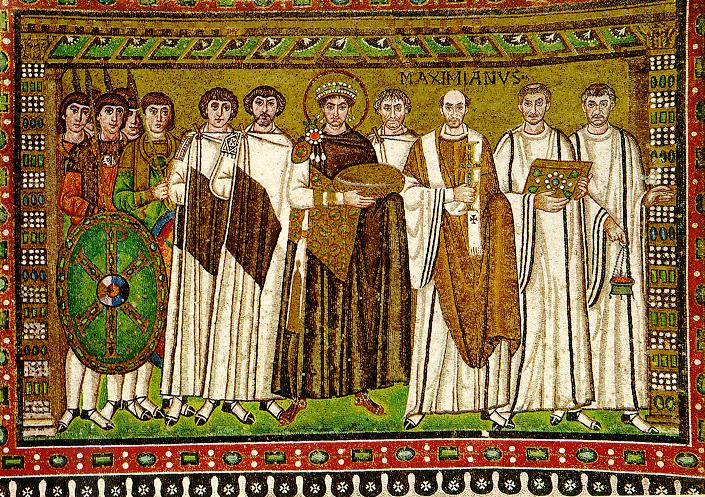
Court of Emperor Justinian with (right) archbishop Maximian and (left) court officials and Praetorian Guards; Basilica of San Vitale in Ravenna, Italy. The bearded man to Justinian’s right is believed to be Belisarius. (via Wikimedia)
The center of social life in Constantinople was the Hippodrome, a massive stadium where chariot races were held. Chariot racing was wildly popular with all strata of society, and everybody was a fan of one team or another; the Blues, the Greens, the Whites, and the Reds. Although as time went on, hardly anybody paid attention to anybody other than the Blues and the Greens. Kinda like Dale Jr. fans and Jeff Gordon fans and who cares about Kurt Busch anymore ’cause he’s a tool.
So, everybody who was anybody was a fan of the Blues or the Greens. You only hung out with fellow Dale fans, all the Jeff Gordon fans voted the same way, you beat the crap out of rival fans in bar fights when you could. Trouble really erupted, however, when some popular ringleaders from each faction were imprisoned on murder raps after a bit of friendly head-busting got out of hand after a contested race.
Dale fans and Jeff Gordon fans united and went wild in the streets, burning and looting and actually laying siege to the palace in a mob scene. The emperor Justinian (via someone expendable, no doubt) announced his willingness to accede to their demands, even to the point of agreeing to abdicate in favor of their choice for a new ruler. Fortunately for Justinian, his wife Theodora and a senior eunuch in the palace bureaucracy named Narses had the stones the emperor lacked. They put their heads together with Belisarius and Mundus, two great Byzantine generals, and hatched a plan.
As the tens of thousands of rioters thronged in the vast Hippodrome, waiting for the new emperor’s coronation, Belisarius and his bodyguard of no more than a couple hundred steppe archers took the passageway under the street from the palace to the imperial box in the stadium. With the crowd focused on the impending ceremony, nobody noticed the archers fanning out in the skybox until they started volleying into the crowd. Panic ensued and, leaving a litter of 24 flags and 88 mesh-back ball caps and shot-up, trampled bodies, the crowd stampeded for the big main gates off the racetrack.
Unfortunately, Mundus and his bodyguard were drawn up in ranks blocking the exit, and they opened fire into the front rows of the fleeing mob. Needless to say, when all was said and done, the backbone of the rioters was broken. Thousands had been shot, and many thousands more were crushed in the press. Justinian held onto his crown, no thanks to his own dithering.
Deadly Moments in History – The Nika Riots
Invicta
Published 27 Feb 2018We relive the deadly Nika Riots which brought the Emperor Justinian to his knees and resulted in the death of 30,000 civilians. In our journey we will explore the history of chariot racing, the undercurrents of dissent, and the blow by blow unfolding of the riot.
Support future documentaries: https://www.patreon.com/InvictaHistory
Twitter: https://twitter.com/InvictaHistoryDocumentary Credits:
Research: Invicta and Luas McCahill
Script: Invicta
Artwork: Robbie McSweeney
Editing: Invicta
Music: Total War Soundtrack, Dreamnote, RecognitionLiterary Sources
–History of the Wars, I by Procopius
–Empress Theodora by J. A. S. Evans
–Justinian: The Last Roman Emperor by G. P. Baker
October 26, 2019
History Summarized: Byzantine Beginnings
Overly Sarcastic Productions
Published 25 Oct 2019It’s Rome! It’s Greece! It’s… The Byzantine Empire! Check out how late Imperial Rome transformed in the centuries from Constantine to Justinian, as it evolved into a new and unique iteration of Roman civilization. Watch as Byzantine craftsmen revolutionize artwork by throwing a megaton of gold onto every last mosaic in the Mediterranean, and radically reimagine architecture by asking “But what if *dome*?”
PATREON: https://www.Patreon.com/OSP
DISCORD: https://discord.gg/sS5K4R3
MERCH LINKS: https://www.redbubble.com/people/OSPY…
OUR WEBSITE: https://www.OverlySarcasticProductions.com
Find us on Twitter https://www.Twitter.com/OSPYouTube
Find us on Reddit https://www.Reddit.com/r/OSP/
January 22, 2018
Khosrau Anushirawan: On Top of the World – Extra History – #5
Extra Credits
Published on 20 Jan 2018Plague had brought an end to Khosrau’s war against Justinian, but Justinian’s nephew soon reignited the rivalry. Khosrau was at the peak of his political power and eager to crush this young upstart personally… but old age had also crept up on him.
January 15, 2018
Khosrau Anushirawan: Trolling Justinian – Extra History – #4
Extra Credits
Published on 13 Jan 2018Iran and Rome had agreed to an Eternal Peace, but tensions between them proved too great and Khosrau decided to invade while Justinian’s guard was down. His army swept into Rome practically unopposed, and he made a mockery of Justinian at every opportunity while treating himself to a grand old time pillaging and parading across the Roman border.
November 26, 2017
The “fall” of the Roman Empire
If you haven’t read much history, you may be aware that the Roman Empire fell in 476 AD. If you have read a bit more history, you’ll be fully aware that the Western Roman Empire fell then … the rest of it lasted nearly another thousand years. Richard Blake, who has a very readable series of novels set in the “blind spot” of history between the collapse of the West and the revival of the Eastern Empire, offers a quick thumbnail sketch of the historical background to his fiction:
In 395 AD, following a century of experiment, the Roman Empire was divided into Eastern and Western administrative zones, with joint Emperors in Rome and in Constantinople. The purpose was to let each Emperor deal with the pressure on his own critical frontiers – the barbarians along the Rhine and Danube frontiers in the West, and the Persians along the Euphrates and desert frontiers in the East.
In theory, each Emperor was equal. In practice, the Eastern Emperor, ruling from Constantinople, was soon the senior partner. During the next two hundred years, becoming increasingly Greek in language in culture, the Eastern Empire flourished, and Constantinople became one of the largest and most opulent cities in the world.
The Western Empire went into immediate and rapid decline. In 406 AD, barbarians crossed the Rhine in large numbers, and broke into Italy. In 410 AD, they sacked Rome. By then, the Western Capital had been moved to Ravenna, a city in North Eastern Italy, impregnable behind marshes, and within easier reach of the frontiers – and within easier reach of Constantinople.
During the next seventy years, the Barbarians took France and Spain and North Africa from the Empire. Britain remained in the Empire, but its people were told to look to their own defence. In 476 AD, the last Western Emperor was deposed. By 500 AD, the whole of the Western Empire had been replaced by a patchwork of barbarian kingdoms.
After 527 AD, the Emperor Justinian began to reach out from Constantinople to reconquer the lost Western provinces. He recovered North Africa and Italy and part of Spain. However, the effort was exhausting. After his death in 568, the Empire lost much of Italy to the Lombard barbarians, and Rome itself fell under papal domination. Slavic and Avar barbarians crossed the Danube and conquered and burned all the way to Athens and the walls of Constantinople. After 602, the Persians began a war of destruction against the Empire. Though they ultimately lost, they did briefly take Egypt and Syria.
October 5, 2017
The greatest general you’ve probably never heard of
I missed this article when it was posted in September: Iskander Rehman discusses the life and times of Byzantium’s greatest general, Belisarius:
In 1780, the great neoclassical painter Jacques-Louis David completed one of his finest works. Entitled “Belisarius Begging for Alms,” the oil painting depicts an aging warrior, blinded with a hand outstretched, seated at the base of a colossal Roman monument. His feet are bare, his beard unkempt, and his armor draped in coarse rags, dull in sheen. A slender walking cane rests to his side, propped against a stone slab bearing the name of a famous former general — Belisario, or Belisarius. A beautiful woman, her face etched in concern, drops a few coins into an upturned helmet, and whispers words of consolation. Her husband, a man in the vigor of youth and full military regalia, is in shock, his arms raised and his mouth open. He has just realized that the stricken veteran is his former commander, the legendary Belisarius himself.
Although his name is not as well known as it once was, Belisarius has long been considered one of history’s finest tacticians. Under the orders of the Byzantine emperor Justinian I, the sixth century general reclaimed vast tracts of Western Roman territory, from northern Africa to the Italian peninsula. Frequently outnumbered and leading an eclectic grouping of warriors composed of romaioi (Eastern Romans), foederati (Barbarian allies), and ethnikoi (specialist ethnic troops), the Thracian commander greatly expanded the footprint of the Byzantine empire at a time when many thought that Rome’s ancestral lands had been irredeemably lost. The fact that many of these conquests, as we shall see, only proved fleeting, has, if anything, only burnished his myth, transmogrifying the soldier into something of a crepuscular icon — Western Europe’s last great Roman protector before the advent of the so-called Dark Ages.
For Liddell Hart, Belisarius was also the consummate practitioner of the so-called “indirect approach” and the “master of the art of converting his weakness into strength; and the opponent’s strength into a weakness.” T.E. Lawrence, an avid reader of the ancient military classics, considered “the Thracian genius” to be one of “three really first-class Roman generals in history” (the other two being Scipio Africanus and Julius Caesar) and encouraged his friend, Robert Graves, to write the novel Count Belisarius. This piece of historically informed fiction retraces Belisarius’s military campaigns and was much admired by Winston Churchill, who is said to have often turned to it for guidance during the fraught early years of World War II.
Who was the man behind the myth? And why do the tales of Belisarius’s life and military exploits continue to resonate, firing the imaginations of great men from David to Churchill and Lawrence of Arabia? What insights can be gleaned, not only from his campaigns, but from the Eastern Roman Empire’s strategic literature more broadly?
March 15, 2016
Justinian & Theodora – Lies 2 – Extra History
Published on 5 Mar 2016
By the time Narses was sent to join him Italy, Belisarius had been away from Constantinople for a very long time. The royal family wasn’t sure if they could still trust him, or if his repeated victories had gone to his head, so they sent Narses (who had been in Constantinople and earned their trust) to keep an eye on him. But this laid the groundwork for disputes that would unravel the military effort there. John looked down on the “barbarian” Ostrogoths and did not consider them a threat, so he viewed the war in Italy as a political battlefield between his friend Narses and his commander Belisarius. Although Procopius defends John’s courage and capability as a cavalry commander, John did not see the bigger picture in Italy and his actions interfered with Belisarius’s overall strategy even though Narses and his family connection to the previous emperor helped keep him safe from repercussions. Belisarius wound up doing the same thing when he refused Justinian’s orders to leave Italy immediately. And in the end, the arrival of the plague – Bubonic Plague, the Black Death – interfered with all their plans. Although we believe Theodora’s actions helped hold the empire together, historians like Procopius take a much darker view: he thought she went power-mad and ruined everything. It’s also worth taking a moment to point out that Theodora was a miaphysite Christian, not a monophysite as we described her in this series. We’ll clarify the difference in a future series on Early Christian Heresies, but for right now we decided to simplify. And there was one thing we left out of this series, a story we love about how Justinian succeeded (where so many had failed) in getting silk worms out of China by bribing monks to smuggle silk worm eggs away in their canes. He helped found a silk industry that brought a lot of money to the empire, and helped it survive longer than it might have otherwise.
March 12, 2016
Justinian – XII: Caesar I was, and am Justinian – Extra History
Published on 27 Feb 2016
Faced with a crumbling empire, Justinian remained determined to realize the dreams of his youth – even though he was now over 65 years old and without Theodora by his side. He worked tirelessly to bring revenue back to the empire, and with money in hand he could finally deal with the forces that threatened it. He assembled his last company, an odd selection of leaders for his army, made up of men who were either old, or inexperienced, or even known for failure – yet they succeeded. His instinct for choosing the right person for the job did not fail him, as one by one his last company made peace with Persia, tamed the Balkan threat, and reclaimed Italy from the Ostrogoths. But fate was not yet done with him. A wave of natural disasters and the return of the plague shook the empire while its foundations were still being rebuilt, and left it vulnerable to an invasion by the Bulgars. Justinian turned to his old friend Belisarius, calling him out of retirement for one final campaign. As always, Belisarius succeeded against the odds, but it would be his last fight. One by one, all of Justinian’s close friends and advisors died of old age. Increasingly alone, he spent his last years trying to consolidate his empire and struggling to reconcile the Christian church. Finally, after one of the longest reigns in Roman history, Justinian died in 565 CE. His reign was a great “What If:” What if all those disasters hadn’t struck? Would his grand ambitions have succeeded? He accomplished so much with the expansion of empire, the construction of the Hagia Sophia, and his overhaul of the legal code. But in the process, he risked – and perhaps lost – everything. He emptied the treasury, overextended the borders, and left the empire vulnerable to the Ottomans years later. Good or bad, his legacy reaches through the centuries to touch our lives today.

